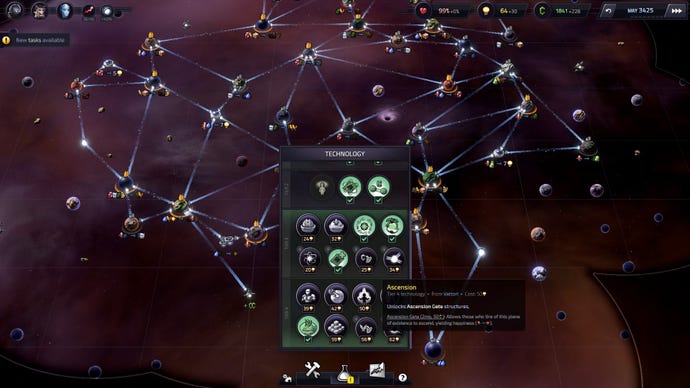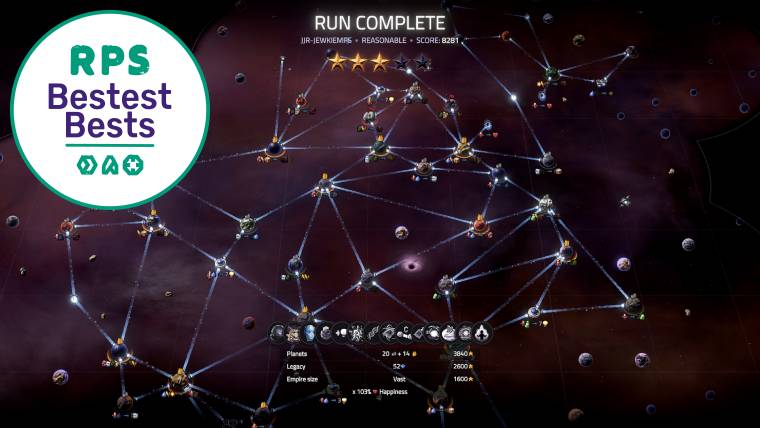Slipways review: schedule-shatteringly moreish
In space, no one can hear you optimise the potential for future synergies
At the centre of Slipways' galaxy is a black hole, and on the other side float the seconds, minutes, and hours this treat of a puzzler has effortlessly siphoned from my weekend. The 4X games this one shares a postcode with can be slow burners, but Slipways' joys are distilled, immediate, and schedule-shatteringly moreish. It’s hyperspace bypass: the game, but thankfully far more thoughtful and pithy than Vogon poetry.
The goal of Slipways is to create a prosperous, star-spanning galactic civilisation by linking up networks of planets so that each has access to the resources it needs to first survive, then thrive. The spice must flow, as they say, but the spice planet needs miners, and the miner planet needs cornish pasties. Ah! The pasty factory world runs on spice. Perfect, because now you can link up the final cog in your self-sustaining planetary cluster and, noticing you’ve got a unit of surplus pasties, start to think about expansion. The titular slipways can’t cross each other, mind, so each expansion needs consideration of future connections.
Each planet has a type, and each type requires imports and produces exports of specific resources. Many planets offer a choice, so you could spec out a forge world to produce either robots or computer chips from minerals, for example. Exactly what types of planets lie beyond your current borders are initially a mystery. To reveal unexplored space you’ll send out probes, which cost both time (Slipways' most important resource) and money (less important, until you have none, which loses you the game.) The distance you can launch probes is limited by the edges of your empire, which means you’ll sometimes have to make risky expansions with no guarantee of future sustainability.
Sustainability is important because of Happiness - Slipways' distillation of the civic and public order stats you’ll usually find in a grand strategy. Here, it’s one number, with a few simple rules. It starts at 100, and if it ever gets below 60, you’ll be booted out of office, presumably into the cold vacuum of space, and lose the run. You’re penalised Happiness for having planets without their basic needs met, units of population that are unemployed by not being utilised, and planets that have no exports. So, while empire size is a scoring factor, you’re encouraged not to expand just because you can, since excessive surplus is actively detrimental. Happiness is also a score multiplier, while money isn’t.

The secret sauce to all of this is a two-fold blend of efficiency and risk-management. The moment you opt-in to colonising a planet, that planet will begin both producing and requiring resources. If you’re fine with temporarily eating the happiness penalty, you can still make use of whatever resource that planet produces. You’ve got a late-game tech planned that’ll nullify the missing resource anyway, right? It’s fine. It’s absolutely fine. Until you get overconfident, leave too many planets screaming into the void for the green goop they so richly crave, and your Scandinavian train network of clean efficiency now resembles a Scalextric track in a washing machine.
The real secret sauce, though, is time. Each standard run lasts 25 years, which is somewhere between 45 minutes to a couple hours in real time. Everything you do, from launching probes to connecting planets with the titular Slipways, costs time. There’s no ticking clock, and you can undo actions provided you haven’t revealed any new information, but everything that yields tangible results saps just a little of the limited time you have for your run. This limitation provides crunchy consequences to each decision, yet frees up Slipways to be this easy-going, bite-sized, almost tabletop-like thing that still manages to scratch many of the same itches as yer Stellaris or Crusader Kings.
"I guess it’s more accurate to call Slipways a grand strategy-themed puzzle game than a 4X-lite."
Variety comes from both the council perks you choose and the random planet seed given to you before each run.This seed can result in a few early restarts, especially as you don’t start with a single colonised planet, and I’ve no doubt that the very best of runs on the higher difficulties will require some good RNG. Otherwise, there’s always something you can do, even if that something involves haphazardly expanding into the endless, twinkling black with no guarantee of future stability.
Before each run, you pick a council of three from five different species. Each council member adds six techs to your pool, and lets you choose one of two perks - which are free, and last the whole run. The Beetleborgs like factories, the Craggy McDiamondfaces like mining, and so on. All of these factors are randomised to varying extents, so while you’re making a choice here, you’re really just guiding your run in a certain direction, amplifying the possibility for future synergies. You can prepare, but you can never plan. But pleasing your council by completing missions based on their own flavour of space requests is a huge factor in both hard numerical score, and getting the tech bonuses you’ll need to score big in other areas.
The final piece of the puzzle is getting your planets from stable (receiving one required resource) to successful and beyond. Bonus resources and several import and export routes will get you so far, then you’ll need to make connected clusters of overachievers, since worlds with successful neighbours themselves thrive. It’s a rule set up for long plays that rewards planning, where knocking over the final domino creates a ripple effect, and you’ll score big for pulling it off.

There is a steep learning curve to all this, despite the game billing itself as something of an instant Zen experience. It’s not a huge undertaking, but it took me one Youtube video and one very helpful Steam guide to start getting the most out of the game. There is a readable tutorial with some moving images included, but I reckon a playable, fixed seed with a friendly robot telling you things like wot Stellaris has would be ideal.
There are also few procedural story elements, which is something I not only associate with 4X but from where much of my love for the genre stems. This is somewhat of an unfair want on my part since Slipways isn’t really trying to tell stories, and story pop-ups might mess with the flow a bit, but, well, here’s an example. There’s a late game tech called an Ascension Gate that lets your spare pops go through and become, like, psychic space angels or something. Nothing happens, really, the resource just gets used up and you get a happiness increase, but ending a run by ascending my people capped off that run’s mini-story nicely. Might be poggers to get some more bits like this, s’all I’m saying.

I have described synth music as ‘bubbly’ more times than I’ve had hot bubble baths, but make no mistake: these boys are some bubbly customers, and very pleasant to listen to. The UI is clean, readable, and replete with all the wondrous, satisfying, space-ass plinks and whooshes you could ever want. There’s a few nice tactile elements, too, like physically dragging each Slipway, or timing the probe-blips for maximum reach, although these can be set to auto-max if you don’t fancy it.
I guess it’s more accurate to call Slipways a grand strategy-themed puzzle game than a 4X-lite, though, in the same way that Into The Breach is a turn-based-tactics-themed puzzle game. Probably. Still, it emulates so much of the other good stuff from 4X. The efficiency puzzle of empire building in a fixed space. The exciting leaps of faith that see you mess with the design perfection you arrived at just moments ago, in the hope of soon establishing something grander. It even manages - miraculously in such a short time frame - to impart the sense of an early, mid, and end game, complete with the lovingly broken snowball at the final hurdle where your tech turns you into a reality-bending deity, providing you invest in tech early.
I suppose, too, that you’ll need to care about scores - about constant improvement - to care about Slipways. Without other species to fight, claim dominion over, or break trade agreements with, your biggest adversaries here are your own impatience, greed, or lack of foresight. Personally, I find these bastards to be worthy opponents, but you may not. There are a few different modes, including a campaign which bends the rules to offer discrete, fixed puzzles, and an endless sandbox mode, but for me, it’s Standard, the best fast food sandwich, that provides the most entertainment.
So, whether you’ve long liked the look of Civilisation but balk at the commitment, or have a seemingly self-replicating collection of untouched Stellaris expansions that you can’t quite find the time for, or honestly just like a good puzzler, I reckon you’ll find something to love here. Personally, Slipways has come at just the right time to occupy a gaming space I wanted filling, but even if it hadn’t, I think it’s a phenomenally smart piece of design. Maybe something will soon come along to replace it, but for now, the view from up here is just perfect. At least, it will be, once I’ve linked that here. Oh, and that there, and… Ah, it’s one of those planets, is it? Well, that changes everything.






